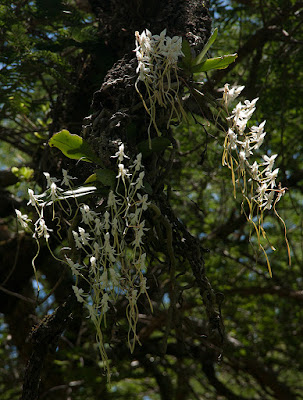Aerangis verdickii is found in Angola, Zaire, Rwanda, Mozambique, Tanzania, Zimbabwe, South Africa, Malawi and Zambia. It grows high on the trees in the woods, quite exposed to light; in nature it is occasionally also found on rocks, but in cultivation it is not lithophytic...
Aerangis verdickii also called as Verdick's Aerangis, Aerangis erythrura, Aerangis verdickii var. rusituensis, Angraecum augustum, Angraecum erythrurum, Angraecum verdickii, is a species of the genus Aerangis. This species was described by Rudolf Schlechter in 1918.
IDENTIFY AERANGIS VERDICKII
Aerangis verdickii is found in Angola, Zaire, Rwanda, Mozambique, Tanzania, Zimbabwe, South Africa, Malawi and Zambia. It grows high on the trees in the woods, quite exposed to light; in nature it is occasionally also found on rocks, but in cultivation it is not lithophytic.
It is a mini-miniature sized, hot to warm growing, smaller, monopodial epiphyte with a short, to 5 cm long but usually very short stem carrying 2 to 6, oblong-ligulate, undulate margins, sub-equally bilobed apically, the lobes acute or obtuse, thick, fleshy, gray green, 2-11 mm long leaves that can be deciduous if the plant dries out in the winter.
Verdick's Aerangis blooms in the spring or summer on a 50 cm long, 10 to 12 flowered, racemose inflorescence with sweet smelling flowers. The white flowers have long spurs, which contain nectar, and are fragrant.
AERANGIS VERDICKII CARE AND CULTURE
Cultural information should only be used as a guide, and should be to be adapted to suit you. Your physical location; where you grow your plants, how much time you have to devote to their care, and many other factors, will need to be taken into account. Only then can you decide on the cultural methods that best suit you and your plants.
Light:
Aerangis verdickii needs a light level of 16000-18000 lux. It must always be protected from direct sunlight. The photoperiod is 12 hours.
Temperature:
In summer, the recommended temperatures are 26-28 ° C during the day and 22-24 ° C at night, while in winter there is a rest period, and the temperatures drop to 20 ° C at most during the day and 15- 16 ° C at night.
Humidity:
Being grown bare-root, Verdick's Aerangis is quite demanding as regards the humidity of the air, which must never fall below 60%. The ideal should be 70-75%.
Substrate, growing media and repotting:
It is recommended to place the Aerangis verdickii with bare root. Its roots need a lot of air, which is not in pot, so if they are stuck inside the substratum they start to rot very quickly. Many growers do not put the sphagnum between the roots and the raft, but I had done it on mine, and the results were very good, so I recommend it with confidence.
Watering:
The annual cycle of this species is divided between the growth period and the rest period. During the growing period the plant gets water frequently and abundantly, once a day (since it is bare-rooted). The sphagnum placed under its roots provides an additional reserve of moisture. In summer, on hot days, I recommend a dampening in the morning and even a spraying after lunch.
Fertilizer:
The cultivated is only fertilized during the growth period. A special liquid fertilizer is used for orchids, taking 1/10 (given that the plant has a bare root) of the dose indicated on its bottle.
Rest period:
Beginning at the end of October, Aerangis verdickii must be prepared to enter the rest period, which is essential for its flowering. During the rest, which lasts from December to mid-February (slightly more than in many other species), the plant does not get water, but only slightly sprinkles every 3-4 days. The air humidity must be at least 70% during the dry period. You will see that the plant will start to get a little dried up, sometimes it can even start to lose its old leaves. If you see that the leaves matured before the period of rest begin to shrivel, turn up the frequency of spraying a little, moving to a light every 2 days. In mid-February the photoperiod should be prolonged (naturally occurring because of longer days, or if you use artificial lighting systems, bring it to 11 hours a day), and the plant will start to awaken, making new growth.















COMMENTS